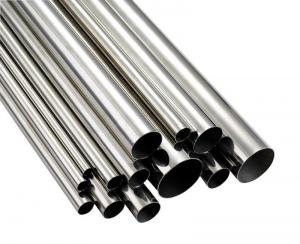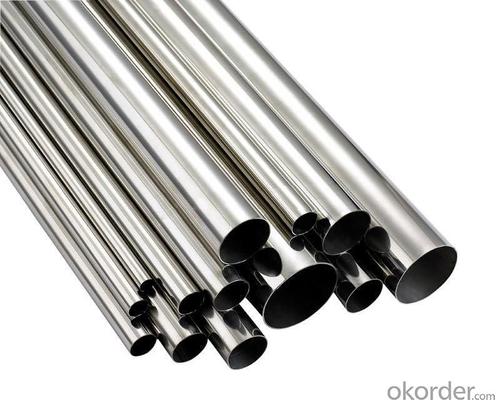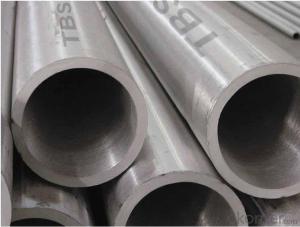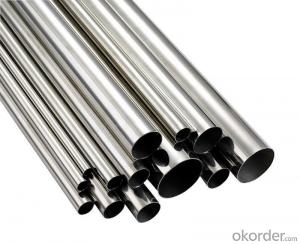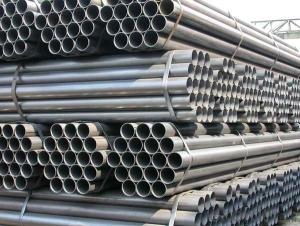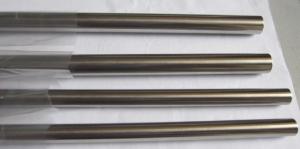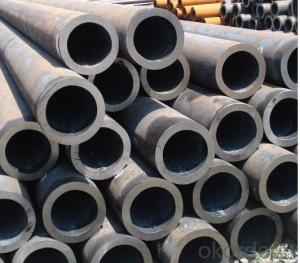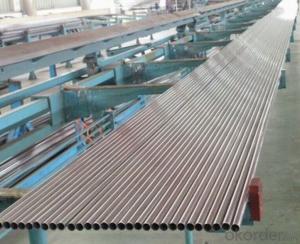Seamless Ferritic Alloy-Steel Pipe for High-Temperature Service in 2015
- Loading Port:
- Shanghai
- Payment Terms:
- TT OR LC
- Min Order Qty:
- 5000 kg
- Supply Capability:
- 10000 kg/month
OKorder Service Pledge
OKorder Financial Service
You Might Also Like
Description:
(1) nominal wall and minimum wall seamless ferritic alloy-steel pipe intended for high-temperature service. Pipe ordered to this specification shall be suitable for bending, flanging (vanstoning), and similar forming operations, and for fusion welding.
(2)Each length of pipe is subjected to the hydrostatic test and examined by a non-destructive examination method in accordance to the required practices. The range of pipe sizes that may be examined by each method is subjected to the limitations in the scope of the respective practices. The different mechanical test requirements for pipes has been passed.
(3)Ferritic steels are defined as low- and intermediate-alloy steels containing up to and including 10 % chromium.
ASTM A335 Seamless Alloy-Steel Pipe
Standard: BS 1139, BS 3059-2, JIS G3454-2007
Grade: 10#-45#, 15NiCuMoNb5, 10Cr9Mo1VNb
Detailed introduction to ASTM A335 seamless alloy steel pipe:
ASTM A335 seamless alloy steel pipe
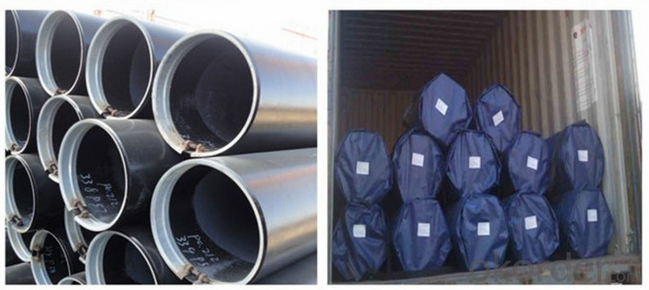
Packaging Detail: | Bundle or Container or as per customers requirement. |
Delivery Detail: | within 25 days after we receive an irrevocable L/Cor 30% deposit |
ASTM A335 Seamless Alloy-Steel Pipe
Standard: BS 1139, BS 3059-2, JIS G3454-2007
Grade: 10#-45#, 15NiCuMoNb5, 10Cr9Mo1VNb
Detailed introduction to ASTM A335 seamless alloy steel pipe:
ASTM A335 seamless alloy steel pipe

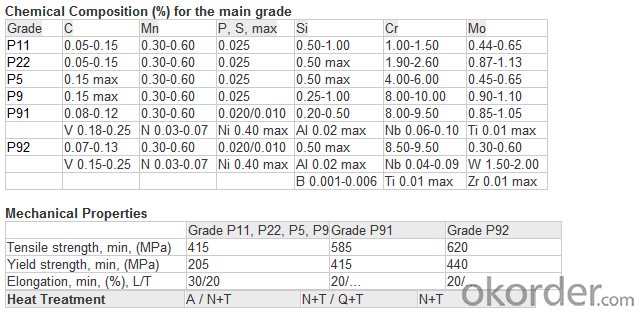
FAQ:
1) why you chose us ?
Professional Manufacturer and supplier of Steel pipe
More than 14 years’ professional producing experience
We can get the lowest ex-factory prices. The price are quite reasonable and it is lower than our commercial peers. also, we can guarantee the qualities of our products.
BV, ISO certificates and SGS test can be provided to assure the quality of our products.
2) Our minimum order quantity:
10 Metric Tons or one 20ft or 40ft Container.
3) How about the Delivery Time?
The steel pipe will be produced since we getting your deposit by T/T or Your original L/C. For normal size, some stocks in our factory now, we can supply once you need.
4)What kind of payment does your company support?
T/T, 100% L/C at sight, Cash, Western Union are all accepted.
5) Do you charge for the samples?
According to our company principle, we just charge for samples, you pay for the freight /courier charge.
6) Main market:
Mid East, South America, Africa, Southeast Asia, India etc
FAQ:
1) why you chose us ?
Professional Manufacturer and supplier of Steel pipe
More than 14 years’ professional producing experience
We can get the lowest ex-factory prices. The price are quite reasonable and it is lower than our commercial peers. also, we can guarantee the qualities of our products.
BV, ISO certificates and SGS test can be provided to assure the quality of our products.
2) Our minimum order quantity:
10 Metric Tons or one 20ft or 40ft Container.
3) How about the Delivery Time?
The steel pipe will be produced since we getting your deposit by T/T or Your original L/C. For normal size, some stocks in our factory now, we can supply once you need.
4)What kind of payment does your company support?
T/T, 100% L/C at sight, Cash, Western Union are all accepted.
5) Do you charge for the samples?
According to our company principle, we just charge for samples, you pay for the freight /courier charge.
6) Main market:
Mid East, South America, Africa, Southeast Asia, India etc
- Q: Are stainless steel pipes suitable for power plant systems?
- Yes, stainless steel pipes are suitable for power plant systems. They offer excellent corrosion resistance, high strength, and durability, making them ideal for transporting various fluids and gases in power plant environments. Additionally, stainless steel pipes can withstand high temperatures and pressures, ensuring reliable and efficient operations in power generation facilities.
- Q: Can stainless steel pipes be used in the water treatment industry?
- Yes, stainless steel pipes can be used in the water treatment industry. Stainless steel is highly resistant to corrosion, making it suitable for use in environments where water is treated and processed. It is often used in various applications within the water treatment industry, including pipelines, pumps, valves, and tanks. Stainless steel pipes offer excellent strength and durability, ensuring long-lasting performance even in harsh conditions. Additionally, stainless steel is hygienic and easy to clean, making it ideal for applications where maintaining water purity is essential. Overall, stainless steel pipes are a reliable and cost-effective choice for the water treatment industry.
- Q: What's the easiest way to distinguish between stainless steel 202 and 304?
- 304# and 202# are American Standard grade 304 is 0Cr18Ni9202shi 1Cr18Nn8Ni5N
- Q: Is stainless steel flexible enough for plumbing applications?
- Yes, stainless steel is flexible enough for plumbing applications. Stainless steel pipes and fittings are known for their durability and strength, but they also offer a certain degree of flexibility. This flexibility allows for easier installation in various plumbing systems, including those with complex layouts or tight spaces. Stainless steel pipes can be bent and shaped without compromising their structural integrity, making them suitable for both residential and commercial plumbing projects. Additionally, stainless steel is highly resistant to corrosion, which is crucial for plumbing applications where exposure to water and other corrosive substances is common. Overall, stainless steel's combination of strength, durability, and flexibility makes it an excellent choice for plumbing applications.
- Q: How do you calculate the flow velocity in stainless steel pipes?
- To calculate the flow velocity in stainless steel pipes, you need to consider several factors. Firstly, you need to know the flow rate or volumetric flow rate (Q) of the fluid passing through the pipe. This can be determined by measuring the volume of fluid passing through the pipe per unit time. Next, you need to determine the cross-sectional area (A) of the pipe. For a circular pipe, this can be calculated using the formula A = πr², where r is the radius of the pipe. Once you have the flow rate (Q) and the cross-sectional area (A), you can calculate the flow velocity (V) using the formula V = Q / A. It is important to note that the flow velocity may vary along the length of the pipe due to factors such as friction and changes in pipe diameter. In such cases, more advanced calculations or simulations may be necessary to accurately determine the flow velocity at specific points within the pipe. Additionally, it is essential to consider the properties of the fluid being transported, such as viscosity and density, as they can also affect the flow velocity.
- Q: How do you prevent blockages in stainless steel pipes?
- To prevent blockages in stainless steel pipes, there are a variety of actions you can take: 1. Make sure to clean the pipes regularly in order to eliminate any buildup of debris or residue. This can be achieved by utilizing different cleaning techniques such as mechanical tools or chemical solutions that are safe for stainless steel. 2. Ensure proper disposal of waste materials by avoiding dumping substances like grease, oil, food scraps, or other solids that can cause blockages. Make use of suitable waste disposal systems or filters to trap these substances before they enter the pipes. 3. Steer clear of corrosive substances, as stainless steel pipes are resistant to corrosion but can still be damaged and blocked by certain highly corrosive substances. Refrain from using or disposing of chemicals or substances that are known to corrode stainless steel pipes. 4. Conduct regular inspections of the pipes to detect any signs of blockages or potential issues. This will aid in identifying problems early on and taking necessary preventive measures. 5. Ensure proper installation of the pipes, including correct alignment, support, and connections. This will help prevent blockages caused by misaligned or poorly connected pipes. 6. Install strainers or filters at the entry points of the pipes to catch any large particles or debris that could potentially block the pipes. Regularly clean or replace these strainers to maintain their effectiveness. 7. Avoid the buildup of high temperatures, as excessive heat can cause substances to solidify or congeal, leading to blockages. Maintain a suitable temperature and prevent sudden temperature changes to avoid allowing substances to cool and solidify in the pipes. 8. Implement a regular maintenance schedule to keep the pipes in optimal condition. This can involve activities such as flushing the pipes with hot water or using specialized cleaning solutions to remove any buildup or residue. By following these preventive measures, you can significantly reduce the likelihood of blockages in stainless steel pipes, ensuring their long-term functionality and minimizing the need for costly repairs or replacements.
- Q: What is the hardness of stainless steel pipes?
- The hardness of stainless steel pipes can vary depending on the specific grade and composition of the steel. However, stainless steel pipes are generally known for their high hardness and durability, which makes them suitable for various industrial applications requiring resistance to corrosion, heat, and wear.
- Q: What is the maximum temperature that stainless steel pipes can withstand?
- The maximum temperature that stainless steel pipes can withstand depends on the grade of stainless steel used. Generally, stainless steel pipes can handle temperatures ranging from 1200 to 1600 degrees Fahrenheit (650 to 870 degrees Celsius), with some specialized grades able to withstand even higher temperatures.
- Q: Are stainless steel pipes resistant to chemical corrosion?
- Yes, stainless steel pipes are resistant to chemical corrosion. This is due to the high levels of chromium present in stainless steel, which forms a protective oxide layer on the surface of the pipes. This oxide layer acts as a barrier, preventing chemical substances from coming into contact with the underlying steel and causing corrosion. Additionally, stainless steel pipes are also resistant to other types of corrosion, such as rusting, making them a popular choice for various industrial, commercial, and residential applications where exposure to chemical substances is expected.
- Q: What is the difference between seamless and cold-drawn stainless steel pipes?
- Seamless and cold-drawn stainless steel pipes are two different types of stainless steel pipes that vary in their manufacturing processes and properties. Seamless stainless steel pipes are manufactured without any welding or seams. They are made by piercing a solid cylindrical billet or ingot of stainless steel and then rolling it into a hollow tube shape. This seamless manufacturing process ensures that there are no weak points or areas prone to leakage, making seamless pipes highly durable and reliable. They also have a smoother interior surface, which allows for efficient fluid flow and reduces the risk of corrosion. On the other hand, cold-drawn stainless steel pipes are manufactured by pulling or drawing a solid stainless steel billet through a series of dies at room temperature. This process helps in achieving precise dimensions and a smooth surface finish. Cold-drawn pipes are typically used in applications where tight tolerances and a high-quality surface finish are required. They are known for their superior dimensional accuracy, excellent surface finish, and increased strength. In terms of properties, seamless stainless steel pipes offer better resistance to corrosion, higher strength, and increased pressure rating compared to cold-drawn pipes. The absence of welds also makes seamless pipes less prone to cracking or failure under high-pressure environments. On the other hand, cold-drawn stainless steel pipes are known for their excellent surface finish, close dimensional tolerances, and improved mechanical properties, making them suitable for applications that require precise measurements and a smooth appearance. In summary, the main difference between seamless and cold-drawn stainless steel pipes lies in their manufacturing processes, resulting properties, and applications. Seamless pipes are manufactured without any welding or seams, offering better resistance to corrosion and higher strength, while cold-drawn pipes are made by pulling solid stainless steel through dies, providing excellent surface finish, dimensional accuracy, and improved mechanical properties.
Send your message to us
Seamless Ferritic Alloy-Steel Pipe for High-Temperature Service in 2015
- Loading Port:
- Shanghai
- Payment Terms:
- TT OR LC
- Min Order Qty:
- 5000 kg
- Supply Capability:
- 10000 kg/month
OKorder Service Pledge
OKorder Financial Service
Similar products
Hot products
Hot Searches
Related keywords
